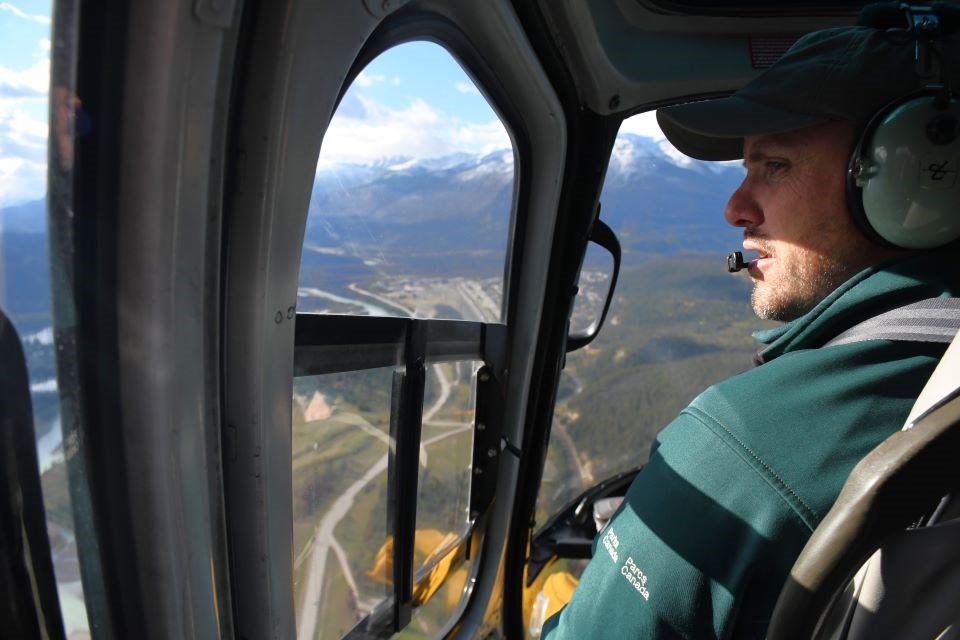JASPER NATIONAL PARK – Jasper National Park does not currently have any visible fires burning on the landscape as Alberta’s wildfire season wrapped up on Thursday (Oct. 31).
While the Jasper wildfire is currently classified as under control, Parks Canada won’t be able to declare the blaze extinguished until it can do a final scan at the start of the next wildfire season and look at some perimeter areas where deeper fuel pockets are located.
“You don't want to rush to that assumption, especially with a fire this large that spans over so much complex topography,” said Landon Shepherd, Jasper National Park’s fire and vegetation specialist. “It’s pretty positive that we haven't had any observations, and we've taken a fair bit of precipitation since early September, so that's good.”
Shepard noted there had been several small pockets of deeper fuels burning south of town in early September, and some smoke had been visible in an isolated spot in the Maligne area until a month ago.
In late July, the Jasper wildfire, caused by lightning strikes, led to the evacuation of 25,000 people and destroyed 30 per cent of the townsite. More than 33,000 hectares burned in Jasper National Park this season, roughly three per cent of the forested area.
Shepard said multiple smaller fires had popped up prior, most notably the Utopia wildfire in the Miette area, because of record-dry conditions.
The Jasper wildfire was powerful enough to create its own thunderstorm clouds, called pyrocumulonimbus clouds.
The wind created was able to lift a 20-foot sea-can weighing 6,700 pounds from Wabasso Campground into the Athabasca River, more than 100 metres. Researchers are now investigating if the wildfire caused a tornado.
First responders from across the country came to Jasper to battle the blaze, including resources from the Alberta government.
“The most dramatic part of the wildfire season in Alberta was the Jasper wildfire,” said Todd Loewen, minister of Forestry and Parks. “It was mostly in federal jurisdiction, but it did take up a lot of the province's resources as well, with wildland firefighters and whatnot.”
Although 700,000 hectares burned in Alberta this season, this is only about a third of what had burned last year. Wildfires north of John D'Or Prairie and south of Fort McMurray also resulted in evacuations this year.
Loewen noted the province would focus on wildfire mitigation work around high-risk communities, particularly those surrounded by coniferous trees. This includes adding fire guards and engaging in FireSmart work.
“We're pushing really hard on that as far as being one of our main goals going into the next fire season, [which] is to see if we can do as much as we can to reduce the fuel load around some of these communities,” he said.
Loewen acknowledged the loss of Alberta Wildfire member Morgan Kitchen, 24, who died fighting the Jasper blaze.
“What happened in Jasper, on a broader scale, affects Albertans and definitely has us in government concerned and something that’s top of mind for us,” the minister added.
Within Jasper National Park, Parks Canada will be busy replanting native species in areas that require a boost and stifling the explosion of invasive weeds. It also anticipates challenges with wildfire movement and detectability.
“You can imagine how easy it will be to form a grizzly bear jam if you can see a grizzly a kilometre away from your vehicle because there’s less cover,” Shepard said.
Because of the massive fuel reduction, the wildfire risk will be much less for the Jasper townsite next year, and Parks Canada will be able to focus on areas that haven’t had that fuel reduction, such as the western valley.
Shepard emphasized Jasper and other at-risk communities would require additional layers of protection besides fuel reduction.
“It's a very seductive trap that people want to fall into is that there's one solution to a very complex problem, and that certainly won't be the only solution,” he said. “It'll just be part of the solution.”
Another part of the solution will be fire-proofing structures. Parks Canada recently amended Jasper’s land use policy to prohibit wood roofing and siding for new buildings, and Banff is considering bylaw changes to better fire-proof the community.
Shepard added how extreme wildfires were becoming the norm in western Canada and would require a collaborative approach.
“We're going to need to work together and collaborate to be able to manage these challenges as we've seen,” he said. “They’re not getting easier. The trend is not for stabilizing or getting easier. The trend is they’re getting harder, so we need to address that.”




